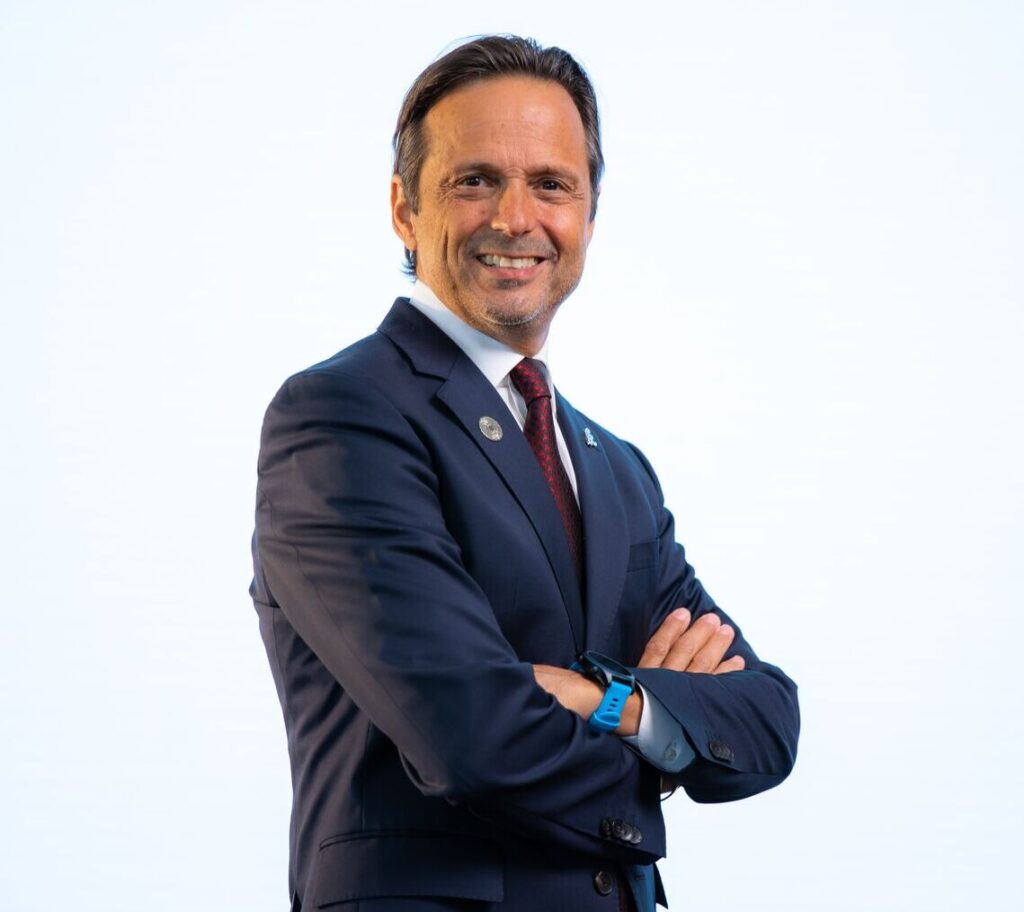Skift Take
As Red Sea Global opens its first destination, it’s moving the needle from traditional sustainability to regeneration. The focus on regeneration marks a shift in industry standards, with potential lessons on how tourism can more actively benefit local communities and environments.
This sponsored content was created in collaboration with a Skift partner.
Destinations worldwide are grappling with the challenge of balancing industry growth with environmental preservation. For Red Sea Global, the goal isn’t just sustainability — it’s restoration and rebuilding. Delivering on its promise of regeneration, Red Sea Global has officially announced the opening of its first destination, The Red Sea. For the developer, the launch marks a new chapter in global tourism, where development and ecological upliftment go hand in hand.
SkiftX sat down with John Pagano, group chief executive officer at Red Sea Global, to discuss the launch of The Red Sea and what it means for the future of destination development.
SkiftX: With travel impacts increasingly under scrutiny, why do you believe regenerative tourism holds the key to shaping a responsible future for the industry?
John Pagano: Pressure from consumers is growing. According to a report by Euromonitor International, 80 percent of travelers are willing to pay at least 10 percent more for sustainable journeys. Given the role of tourism in pollution and climate change, we see a moral obligation to go beyond just meeting this demand.
More importantly, sustainable tourism aims to protect the environment, but that’s not enough to contribute meaningfully to the UN’s Sustainable Development Goals (SDGs). To do this, we need to actively enhance the environment and local communities, which is why we believe regenerative tourism is the future.
SkiftX: How has The Red Sea created a regenerative tourism blueprint that other destinations can use as a benchmark and look to adopt?
Pagano: We undertook a comprehensive marine spatial planning simulation in partnership with King Abdullah University of Science and Technology, which helped to inform our final plan and gauge the impact of development on the environment. Consequently, we decided to develop only 22 of the over 90 islands at The Red Sea and designated nine as special conservation zones.
By 2040, we aim for a 30 percent net conservation benefit at our destinations by enhancing biologically diverse habitats, including mangroves, seagrass, corals, and land vegetation. Our marine biology team monitors about 300 coral reef sites, and we’re in the pilot phase of creating artificial reefs, exploring what structures and types of materials would promote growth and enable marine species to not only survive but thrive, for generations to come. Our Mangrove Nursery aims to plant 50 million mangrove trees by 2030 in partnership with the National Center for Vegetation Cover.
Both The Red Sea and Amaala will run on 100 percent renewable energy. We’ve installed five solar farms at The Red Sea and laid our 760,000th photovoltaic panel for Phase One.
We’re also committed to local community development and have contributed to the creation of 120,000 jobs across the Kingdom, offering vocational training in various fields. Additionally, our English for Tourism program helps equip young Saudis with essential language skills for the industry.
SkiftX: What’s the current status of The Red Sea destination, and what can travelers expect when they visit?
Pagano: We’re excited to announce that The Red Sea is now open. Six Senses Southern Dunes welcomed its first guests in November, and The St. Regis Red Sea Resort on Ummahat Islands is also accepting bookings. Nujuma, one of only six Ritz-Carlton Reserves worldwide, will open in early 2024.
Serving these hotels is The Red Sea International Airport, which celebrated its first flight in September. Already the airport has a busy schedule of domestic flights, with international routes coming soon.
When The Red Sea is completed in 2030, the destination will be home to 50 hotels across 22 islands and six inland sites. It will include luxury marinas, golf courses, entertainment options, F&B outlets, and leisure facilities, underlining our commitment to the future of global tourism.
SkiftX: What challenges have you encountered in realizing this vision, and how have you navigated them?
Pagano: When we started six years ago, we knew that delivering our vision would be challenging given the sheer scale of The Red Sea destination. The area spans over 10,810 miles (28,000 square kilometers), bigger than almost a third of European countries.
The destination requires a large workforce, which raises an urgent need to upskill the local population. We’re creating a substantial pool of qualified professionals through our vocational training programs in partnership with the Human Resources Development Fund and King Abdulaziz University.
We’re also developing sandy islands, sweeping deserts, and mountain crags — varied terrain presenting multiple accessibility challenges. We’ve ensured that our employees, consultants, and partners follow the United Nations-backed Accessible Tourism For All guidelines, putting accessibility at the heart of the construction process. Every request for proposal and every contract awarded from our design, architecture, and development team adheres to this standard.
SkiftX: Engaging with the local community seems to be an important part of Red Sea Global’s strategy. How have local insights and needs shaped the development of the destination?
Pagano: A focus on community underpins all our activities. This involves regular dialogue with elders to seek their approval on local initiatives, as well as the launch of a partnership with the University of Tabuk to research the socio-economic and cultural standing of the communities around The Red Sea and Amaala. This study will also guide our future plans for other destinations and help us create social programs aimed at building a more entrepreneurial and economically stronger Saudi Arabia.
We’ve also launched socioeconomic empowerment projects such as Souq Amerah, a local market where farmers, craftsmen, and artists showcase and sell foods, merchandise, crafts, and other products. The market hosted traditional music performances and cultural heritage workshops in a “Tent of Tales.” The ambition is to showcase and celebrate the community’s traditions and talents and bring Saudi Arabia’s rich cultural history to a broader audience in an engaging format. This will help us improve the quality of life for the people we’re proud to call our neighbors.
SkiftX: How does Red Sea Global’s approach align with the UN Sustainable Development Goals, and how are you ensuring measurable contributions?
Pagano: Our work aligns with all 17 UN Sustainable Development Goals. For example, The Red Sea will be the world’s largest destination powered solely by renewable energy, achieving SDG 7, “Ensure access to affordable, reliable, sustainable and modern energy for all.” At the same time, The Red Sea and Amaala will contribute a combined $8.8 billion (SAR33 billion) boost to Saudi Arabia’s GDP, achieving SDGl 8, “Promote sustained, inclusive and sustainable economic growth, full and productive employment and decent work for all.”
SDG 14, “Conserve and sustainably use the oceans, seas, and marine resources for sustainable development,” is also a major focus area as we nurture the thriving marine ecosystem along Saudi Arabia’s Red Sea coast. We use floating nurseries with about 8,000 coral colonies and draw on the latest marine technologies to monitor their health and growth. We’re committed to tracking and openly reporting our progress, as seen in our annual Sustainability Report that covers all our projects.
Our Environmental Baseline Survey, the largest by a property developer, examined wildlife and habitats along 125 miles (200 kilometers) of the Red Sea coast. The study helped us track endangered species such as the Hawksbill turtle and Sooty falcon and is helping us achieve significant conservation benefits by 2040.
SkiftX: What are your recommendations to other industry stakeholders looking to adopt a regenerative model?
Pagano: Not every tourism developer has the resources to implement regenerative tourism on such a scale. But by committing to environmental and community improvement at its heart, organizations can ensure that these values guide every development decision. We recommend investing time to understand the needs of the local community and the surrounding ecological habitats before undertaking any development activity. A deep understanding of the development area also helps monitor progress and communicate this transparently to all relevant stakeholders. This provides a baseline to measure against, allowing tourism executives to set meaningful long-term goals focused on active enhancement rather than simply protection.
Learn more about Red Sea Global.
This content was created collaboratively by Red Sea Global and Skift’s branded content studio, SkiftX.
Have a confidential tip for Skift? Get in touch
Tags: red sea global, regenerative tourism, responsible tourism, SkiftX Highlights, SkiftX Showcase: Destinations, sustainability, sustainable tourism


